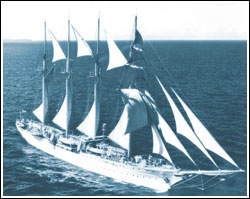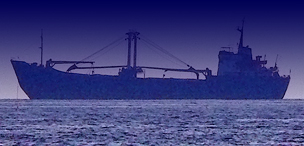The Rime of the Esmeralda
06/09/10 16:27 Archiviato in: Stories
About ten years ago, I was on my way out of a hotel in Santiago de Chile, when an old man asked me if I wanted to buy a model ship. It was a beautiful, four-masted schooner. Sleek and completely white. “Her name is Esmeralda. We called her the White Lady”, said the old man, who went on to boast that he had served on her crew. He was not charging much so I bought it. And carried it with me on my travels to Patagonia. “I’m on a voyage with Esmeralda”, I’d chuckle to myself.
Once I got back to Italy I set the model ship on my bookshelf. Then, when I moved to a smaller apartment, I had to store it under my bed, but I always meant to let her unfurl her sails again once I’d eventually got a bigger place. My umpteenth move took me and Esmeralda to the home of another former sailor, who, like any old sailor would, began searching for Esmeralda’s history.
And unfortunately he found it.
Esmeralda, a training ship for the Chilean Navy, entered service in 1954 and between 1973 and 1980, under the dictatorship of Augusto Pinochet, was used as a floating jail and torture chamber. According to reports by Amnesty International, the US Senate and the Chilean Truth and Reconciliation Commission, at least one hundred people became victims of the death cruises. It’s a story that came to be known as “the dark side of the White Lady”.
Esmeralda is still used today as a training ship. She also takes part in regattas and shows. She is much admired, but also contested as symbolising the impunity still enjoyed by many criminals of Pinochet’s regime.

After making this discovery I didn’t know what to do with my model Esmeralda. She seemed to be the materialisation of the vessel in The Rime of the Ancient Mariner by Samuel T. Coleridge, a symbol of fear and disaster.
I wondered who the old sailor that sold it to me could have been or, worse, could have done. I began to think that evil could be passed on, like an infection, from men to ships, ships to men, men to model ships. And, finally, to me.
Should I keep it, as a personal object of meditation, a sign of the attention that should be paid in our every action, of the vital curiosity that leads us to search for the meaning of everything?
Or should I get rid of it, as a way of exorcising any evil it may hold within?
In the end I decided to let it go in the sea. I would swim far away from the shore and leave it out there, in the hope that that would somehow atone for the victims. That would also be in keeping with the spirit of the ship and purify it of the evil it had witnessed and been contaminated by.
And that’s what I did one beautiful September morning. The water was still warm but a sharp north-east wind was whipping up two-foot waves that broke against a barrier of rocks thirty or so yards off the shore. I swam beyond those rocks, pushing Esmeralda out in front of me as I went. When I thought I was far enough out, I let her go. She tipped to the left, showing her green keel, a little darker than the water. She was still beautiful, and quite at ease on the water. I watched as the current carried her quickly away from me. I turned back to shore and started swimming faster than usual, keeping my head underwater and trying to imagine the sea bed and its ghosts. When I stopped, she had disappeared from view behind the crest of the nearest wave.
As soon as I got back to the shore a kid came up to me. “Where’s your ship?” he asked.
“I let it go”.
“Why?”.
“Because it was a bad ship”.
“But bad ships are black and have the skull and crossbones. Yours was all white”.
“It was still bad though”.
I didn’t think a kid with Captain Hook on his mind would understand the concept of karma or of cosmic order. Then I wondered whether I understood it myself. Whether, in the end, Esmeralda was innocent and I hadn’t been trying to get rid of something inside me, to wash it away in the sea water.
On a lookout above the sea the old sailor who had revealed the history of the Esmeralda was waiting for me. He had watched the model ship drift and eventually smash against a rock. I looked up the exact coordinates: 43°37’05.01” N and 13°32’02.73” E.
Sooner or later, in a few months maybe, when the water is cold and the sea calm, I might dive down to look for her. Perhaps I’ll find the answer to the voices troubling the Coleridge’s Ancient Mariner:
But tell me, tell me! speak again,
Thy soft response renewing –
What makes that ship drive on so fast?
What is the ocean doing?

Once I got back to Italy I set the model ship on my bookshelf. Then, when I moved to a smaller apartment, I had to store it under my bed, but I always meant to let her unfurl her sails again once I’d eventually got a bigger place. My umpteenth move took me and Esmeralda to the home of another former sailor, who, like any old sailor would, began searching for Esmeralda’s history.
And unfortunately he found it.
Esmeralda, a training ship for the Chilean Navy, entered service in 1954 and between 1973 and 1980, under the dictatorship of Augusto Pinochet, was used as a floating jail and torture chamber. According to reports by Amnesty International, the US Senate and the Chilean Truth and Reconciliation Commission, at least one hundred people became victims of the death cruises. It’s a story that came to be known as “the dark side of the White Lady”.
Esmeralda is still used today as a training ship. She also takes part in regattas and shows. She is much admired, but also contested as symbolising the impunity still enjoyed by many criminals of Pinochet’s regime.

After making this discovery I didn’t know what to do with my model Esmeralda. She seemed to be the materialisation of the vessel in The Rime of the Ancient Mariner by Samuel T. Coleridge, a symbol of fear and disaster.
I wondered who the old sailor that sold it to me could have been or, worse, could have done. I began to think that evil could be passed on, like an infection, from men to ships, ships to men, men to model ships. And, finally, to me.
Should I keep it, as a personal object of meditation, a sign of the attention that should be paid in our every action, of the vital curiosity that leads us to search for the meaning of everything?
Or should I get rid of it, as a way of exorcising any evil it may hold within?
In the end I decided to let it go in the sea. I would swim far away from the shore and leave it out there, in the hope that that would somehow atone for the victims. That would also be in keeping with the spirit of the ship and purify it of the evil it had witnessed and been contaminated by.
And that’s what I did one beautiful September morning. The water was still warm but a sharp north-east wind was whipping up two-foot waves that broke against a barrier of rocks thirty or so yards off the shore. I swam beyond those rocks, pushing Esmeralda out in front of me as I went. When I thought I was far enough out, I let her go. She tipped to the left, showing her green keel, a little darker than the water. She was still beautiful, and quite at ease on the water. I watched as the current carried her quickly away from me. I turned back to shore and started swimming faster than usual, keeping my head underwater and trying to imagine the sea bed and its ghosts. When I stopped, she had disappeared from view behind the crest of the nearest wave.
As soon as I got back to the shore a kid came up to me. “Where’s your ship?” he asked.
“I let it go”.
“Why?”.
“Because it was a bad ship”.
“But bad ships are black and have the skull and crossbones. Yours was all white”.
“It was still bad though”.
I didn’t think a kid with Captain Hook on his mind would understand the concept of karma or of cosmic order. Then I wondered whether I understood it myself. Whether, in the end, Esmeralda was innocent and I hadn’t been trying to get rid of something inside me, to wash it away in the sea water.
On a lookout above the sea the old sailor who had revealed the history of the Esmeralda was waiting for me. He had watched the model ship drift and eventually smash against a rock. I looked up the exact coordinates: 43°37’05.01” N and 13°32’02.73” E.
Sooner or later, in a few months maybe, when the water is cold and the sea calm, I might dive down to look for her. Perhaps I’ll find the answer to the voices troubling the Coleridge’s Ancient Mariner:
But tell me, tell me! speak again,
Thy soft response renewing –
What makes that ship drive on so fast?
What is the ocean doing?




